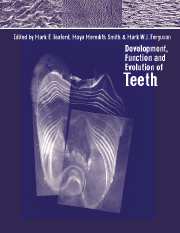Book contents
- Frontmatter
- Contents
- List of contributors
- Acknowledgements
- Part one Genes, molecules and tooth initiation
- 1 Homeobox genes in initiation and shape of teeth during development in mammalian embryos
- 2 Return of lost structure in the developmental control of tooth shape
- 3 Molecules implicated in odontoblast terminal differentiation and dentinogenesis
- 4 Enamel biomineralization: the assembly and disassembly of the protein extracellular organic matrix
- Part two Tooth tissues: development and evolution
- Part three Evolution of tooth shape and dentition
- Part four Macrostructure and function
- Index
4 - Enamel biomineralization: the assembly and disassembly of the protein extracellular organic matrix
Published online by Cambridge University Press: 11 September 2009
- Frontmatter
- Contents
- List of contributors
- Acknowledgements
- Part one Genes, molecules and tooth initiation
- 1 Homeobox genes in initiation and shape of teeth during development in mammalian embryos
- 2 Return of lost structure in the developmental control of tooth shape
- 3 Molecules implicated in odontoblast terminal differentiation and dentinogenesis
- 4 Enamel biomineralization: the assembly and disassembly of the protein extracellular organic matrix
- Part two Tooth tissues: development and evolution
- Part three Evolution of tooth shape and dentition
- Part four Macrostructure and function
- Index
Summary
Introduction
The component tissues of teeth include an outer enamel cover over underlying dentin. Enamel is almost completely inorganic mineral, so much so that it has been said that teeth emerge into the mouth as preformed fossils (Boyde, 1996). While this notion certainly reflects the biological function of teeth as elements of the masticatory apparatus, it regrettably and erroneously implies that the formation of teeth is a simple or passive affair. This is not the case and the dentition represents a remarkable and elegant biological adaptation of dermal appendages whose emergence coincides with vertebrate radiation. This is not surprising since teeth provide for increased nutrition through enhanced food processing, as well as providing formidable weapons of offense and defense, and hence, animals bearing teeth might well be predicted to compete more efficiently in a specific niche.
Tooth development has been studied in detail for several decades because it provides a useful model for instructive interactions occurring between dissimilar germ layers. These epithelial-mesenchymal interactions are responsible for the majority of vertebrate organogenesis, including hair, pancreas, mammary gland, salivary gland, thymus, vibrissae, and others. We will not include a detailed analysis of such interactions in this review except where they relate to control of amelogenin gene expression. The reader is directed to several excellent reviews that have recently appeared (Weiss et al., 1994; Thesleff et al., 1995; Zeichner-David et al., 1995; Maas and Bei, 1997). We are cognizant of several exceptional treatments of the field of biomimetics, biomineralization and enamel formation over the past several years and readers are directed to these scholarly works for alternative views of enamel formation (Fearnhead, 1989; Lowenstam and Weiner, 1989;
- Type
- Chapter
- Information
- Development, Function and Evolution of Teeth , pp. 37 - 62Publisher: Cambridge University PressPrint publication year: 2000
- 13
- Cited by



